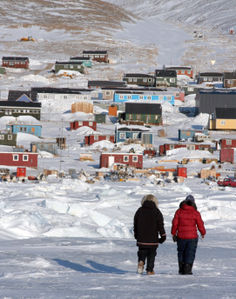Continuous Discontinuous Sporadic or Isolated Permafrost
Permafrost

Figure 1. An image of permafrost[1]
Permafrost, a permanently frozen layer below some parts of the Earth's surface (usually in the Arctic or Antarctic), consisting of soil, gravel, and sand, held together by ice.[2] Frozen ground is often confused with permafrost but they aren't the same. Any layer of soil that freezes for more than 15 days in a year is called 'seasonally frozen ground.' A layer of soil that freezes between one and 15 days a year is called 'intermittently frozen ground.' Permafrost typically remains at or below 0°C for at least two years.[2] Found in areas with temperatures below 0°C for most of the year, permafrost can be found in Arctic regions such as Northern Canada, Greenland, Russia, and China. Permafrost is often located on land but also exists below some parts of the ocean floor. It generally can range in thickness from 1 meter to more than 1,000 meters.[2] It stretches approximately 22.8 million square kilometers in the Earth's Northern Hemisphere.[2]
As long as the temperature in the ground stays below the freezing point, permafrost does not have to contain any water or ice, even it is completely dry.[3] If permafrost begins to warm significantly, it thaws.
Permafrost and the climate
Permafrost does not always form in one solid sheet. There are two major ways to explain its formation: continuous and discontinuous.
- Continuous permafrost is defined in the name itself, which is a continuous sheet of frozen material. Continuous permafrost extends under all surfaces except large bodies of water in the area.[4] It exists under almost the entire land surface in an area. Areas with continuous permafrost often have permafrost layers more than 100 meters thick.[3] The deepest continuous permafrost ever found is in Siberia, with the region having a permafrost layer that extends down 1650 meters.[3]

Figure 2. Map depicting permafrost extent[5]
- Discontinuous permafrost is broken up into separate region. Discontinuous permafrost can be isolated or sporadic. It is called isolated if less than 10% of the surface has permafrost under it. Sporadic means 10% to 50% of the surface has permafrost under it.[3] Certain permafrost, casted from a shadow of a mountain or covered in thick vegetation, stay all year. Alpine permafrost is discontinuous permafrost that exists on the tops of mountains where the ground stays very cold. In other areas of discontinuous permafrost, the summer sun thaws the permafrost for several weeks or months.[4] The land near the southern shore of Hudson Bay, Canada, has discontinuous permafrost. It exists under a large portion of a particular area or only in a few specific places. In areas with discontinuous permafrost, the permafrost layer can extend as deep as 10 meters underground.[3]
Under the Arctic Ocean, which covers the North Pole, some of the sea floor is frozen. Permanently frozen sea floor is called subsea permafrost. Subsea permafrost formed more than 11,000 years ago, during the last ice age.[6] Back then, more of Earth's water was trapped as ice on land. That caused the sea level to be lower than it is today. More land was exposed, and some of it froze. Then the ice age ended and the seas rose again. When the sea level rose, the oceans covered up areas of permafrost. Today, some of the sea floor is frozen up to 100 meters thick under the bottom of the ocean.[6] Subsea permafrost exists only under the Arctic Ocean and does not exist in the Southern Hemisphere. Scientists have theorized that Mars may have permafrost. The NASA Phoenix mission found a terrain feature called patterned ground on Mars. On Earth, patterned ground is only found in regions where permafrost exists.[6]
Climate Change and Permafrost
Scientists who study permafrost are able to understand changes in the Earth's climate by observing changes in permafrost. Studies show the Earth's permafrost warmed by 6°C during the 20th century. Scientists predict widespread thawing of permafrost by 2100.[4] Thawing permafrost would raise water levels in the Earth's oceans and increase levels of erosion.[4] Erosion occurs when permafrost thaws because soil and sediment are easily washed away without ice binding them together.[4]
- Permafrost and people
-

Qannaaq, Greenland, built entirely on permafrost[7]
-

Permafrost thawed under this house in Dawson City, British Colombia (Canada) and the house was damaged.[8]
-

The Alaskan pipeline has warm oil flowing through it which could thaw permafrost, so it must be raised (it also allows the oil to stay warmer).[9]
For more information on permafrost and frozen ground please see NOAA or the NDIC.
References
- ↑ Natural Resources Canada. (July 22, 2016). ''Permafrost'' [Online]. Available: http://www.nrcan.gc.ca/sites/www.nrcan.gc.ca/files/earthsciences/images/ice-rich-pf.jpg
- ↑ 2.0 2.1 2.2 2.3 H. Lantuit, "What is Permafrost?", Ipa.arcticportal.org, 2016. [Online]. Available: http://ipa.arcticportal.org/publications/occasional-publications/what-is-permafrost. [Accessed: 03- Jun- 2016].
- ↑ 3.0 3.1 3.2 3.3 3.4 "How Does Permafrost Form| National Snow and Ice Data Center", Nsidc.org, 2016. [Online]. Available: https://nsidc.org/cryosphere/frozenground/how_fg_forms.html. [Accessed: 03- Jun- 2016].
- ↑ 4.0 4.1 4.2 4.3 4.4 "International Permafrost Association", Ipa.arcticportal.org, 2016. [Online]. Available: http://ipa.arcticportal.org. [Accessed: 02- Jun- 2016].
- ↑ National Oceanic and Atmospheric Administration. (July 22, 2016). ''Permafrost'' [Online]. Available: http://www.arctic.noaa.gov/permafrost-photos/web/circumpolar-permafrost-extent.jpg
- ↑ 6.0 6.1 6.2 "Permafrost | National Snow and Ice Data Center", National Snow and Ice Data Center, 2016. [Online]. Available: https://nsidc.org/cryosphere/frozenground/whereis_fg.html. [Accessed: 03- Jun- 2016].
- ↑ Andy Mahoney/NSIDC available online: http://nsidc.org/cryosphere/frozenground/people.html accessed August 1st, 2016.
- ↑ Credit: Andrew Slater NDIC, available online: http://nsidc.org/cryosphere/frozenground/people.html accessed August 1st, 2016.
- ↑ Credit: Tingjun Zhang, NDIC, available online: http://nsidc.org/cryosphere/frozenground/people.html accessed August 1st, 2016.
Source: https://energyeducation.ca/encyclopedia/Permafrost
0 Response to "Continuous Discontinuous Sporadic or Isolated Permafrost"
Post a Comment